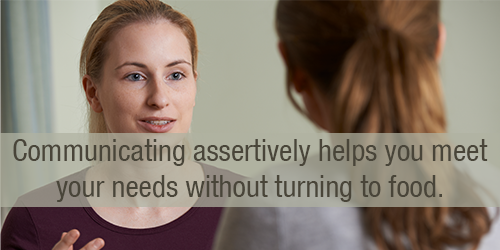Being in healthy relationships with others requires excellent communication. Let’s explore how assertive communication can improve your relationships, which in turn, makes it easier to manage your relationship with food.
What does communication have to do with eating?
This excerpt from Eat What You Love, Love What You Eat for Binge Eating explains why your relationships with others are an important part of healing your relationship with food and your body.
Bringing mindfulness—intention and attention—into your relationships with others reduces conflict, decreases emotional distress, increases your opportunities to meet your needs, makes for more satisfying connections with others, and decreases the likelihood that you will turn to food to try to meet your need for satisfying relationships. An important part of recovery is to replace your relationship with food with relationships involving other people. Food will then take its proper place: nourishing and fueling your body.
Start by setting an intention for your relationships, such as, “I will strive to be respectful, attentive, and loving toward myself and others.” Focus your attention during your interactions in order to actively listen, validate, assertively communicate, and resolve conflict.
Assert Yourself to Improve Your Relationships
 Many people use food to stuff, express, or deal with difficult, uncomfortable, or painful emotions. This can lead to the Overeating Cycle or the Binge Eating Cycle.
Many people use food to stuff, express, or deal with difficult, uncomfortable, or painful emotions. This can lead to the Overeating Cycle or the Binge Eating Cycle.
In contrast, assertiveness is a way of expressing one’s boundaries and needs directly, with the goal of improving relationships and increasing intimacy.
For example, people who are afraid of conflict and expressing anger may avoid confrontation, and instead turn their anger inward or bottle it up until they ultimately express it in an explosion of rage that feels out of control and scary. This reinforces their fear of expressing their anger, creating a destructive cycle.
However, anger is a normal emotion that can be dealt with effectively and assertively. Assertiveness is a way of taking responsibility for your thoughts, feelings, and needs and ensures that you will create healthy and self-protective boundaries in your relationships.
Assertive communication increases the likelihood you will get your needs met and enables others to know what you want from them without being “mind readers.” When you’re able to express your displeasure, you give the other person the opportunity to learn what types of behavior will be damaging and what types of behavior will enhance the relationship.
Assertiveness Training 101
 People often confuse assertiveness with aggressiveness. However, one of the chief differences is where you place your needs relative to others:
People often confuse assertiveness with aggressiveness. However, one of the chief differences is where you place your needs relative to others:
- Aggressive: Consistently placing your needs ahead of everyone else’s needs.
- Assertive: When you consistently find a healthy balance between your needs and others’ needs. At times your needs come first, at times others’ needs may come first.
- Non-assertive: Consistently placing everyone else’s needs ahead of your own.
Assertive Communication
The key to assertive communication is taking responsibility for your own feelings and communicating your needs clearly without being passive, aggressive, or both.
When you communicate your needs without blaming or judging, and state what you want, need, or prefer, you give others the ability to decide whether to meet those needs.
Assertiveness Script
Blaming or accusing someone by using “you” statements, such as, “You hurt my feelings,” tends to make the person feel defensive and pushes them further away.
Conversely, “I” statements, such as, “I feel hurt,” puts you in charge of your own emotions and reactions, and draws the other person closer.
The following script will help guide you to communicate your needs assertively.
When you ________________________ (describe behavior),
I feel/felt _________________________ (describe feeling)
and I want/need/would prefer __________________ (describe desired behavior).
Example: When you speak critically about me, I feel hurt and inadequate. I need to hear you say that you love and appreciate me more often.
In addition to these I statements, assertive communication includes non-defensive body language, good eye contact, and clear messages delivered in a calm tone. Practice using this script to communicate your feelings, thoughts, and boundaries to others effectively and assertively, instead of reaching for food.
This article is updated from a previous version.
If you enjoyed this article, here are three more to help you:
Mindful Relationships Part 1: Personal Boundaries and Eating
Are you an emotional eater? Label the behavior, not yourself!
How mindful eating opens the door to mindful living


